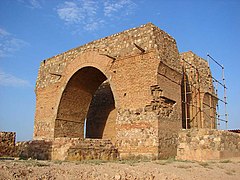Chahartaq (architecture)
Chartaq (Persian: چارطاق), chahartaq (چهارطاق), chartaqi (چارطاقی), or chahartaqi (چهارطاقی),[1] literally meaning "four arches", is an architectural unit consisted of four barrel vaults and a dome.
History
Chartaqi was a prominent element in Iranian architecture, having various functions and used in both secular and religious contexts for 1,500 years, with the first instance apparently being developed in Gor (Firuzabad), Pars, in 210s AD by Ardashir I. The biggest instance of chahartaq is that of the so-called Palace of Shapur I at Bishapur. Many pre-Islamic chahartaqs have been survived, but they are usually just the sole surviving structure of a much bigger complex. The structure was adopted in Islamic architecture of Persia.[2]
A related concept is čahārqāpū (چهارقاپو).[2]
-
Chartaqi of Neyasar at Neyasar, Kashan, Iran. Late Arsacid
or early Sassanian era. It is one of the few intact chartaqis. -
Chahartaqi of Kheirabad, Sassanian period
-
Chahartaq in Sarab, East Azerbaijan Province. Sassanian period
-
Ateshgah of Baku. Many chartaqis were part of a fire temple
-
Chartaqi of Karchan
-
Chahartaqi of Konarsiyah
-
Chartaq on top of the Harpak fire temple in Abyaneh
Contemporary architecture
The main plan of the Azadi Tower is said to be influences by the architecture of chartaqis.[3][4]
-
Monument of Molla Hossein Kashefi, Sabzevar, built in 1974.
The post-modern design has incorporated the concepts
of chahartaqi and iwans. -
Scholars Pavilion (the Scholars Chartagi) in Vienna, a
chahartaqi with elements from the architecture of Persepolis
See also
References
- ^ Also transliterated with gh instead of q.
- ^ a b Dietrich Huff, "ČAHĀRṬĀQ", Encyclopaedia Iranica, December 15, 1990
- ^ http://bonyadroudaki.com/PContent.aspx?id=22&&lang=fa-IR
- ^ https://www.chidaneh.com/ideabooks/life-style/travel-design/38834












